You only need to bring your Indiana Jones hat to the Cobá Mayan ruins to feel in full exploration mode as you stand in front of unrestored pyramids emerging from the depths of the jungle.
From a small lakeside community with a hunting and agricultural-based economy, the Mayan city of Cobá transformed into an urban centre with a population of 55,000 people by the 8th century.
It became the capital of the region, controlled other cities, and traded with far away centres such as Petén in Guatemala and settlements in the Gulf Coast.
Cobá, meaning turbulent waters, is the original name of this place located 44 kilometres northwest of Tulum, in the state of Quintana Roo.
Disclosure: This post contains some affiliate links. If you make a purchase through those links I will earn a commission at no additional cost to you (zero, nada). To check the full disclaimer, click here.
This is your complete guide to the Coba Mayan ruins
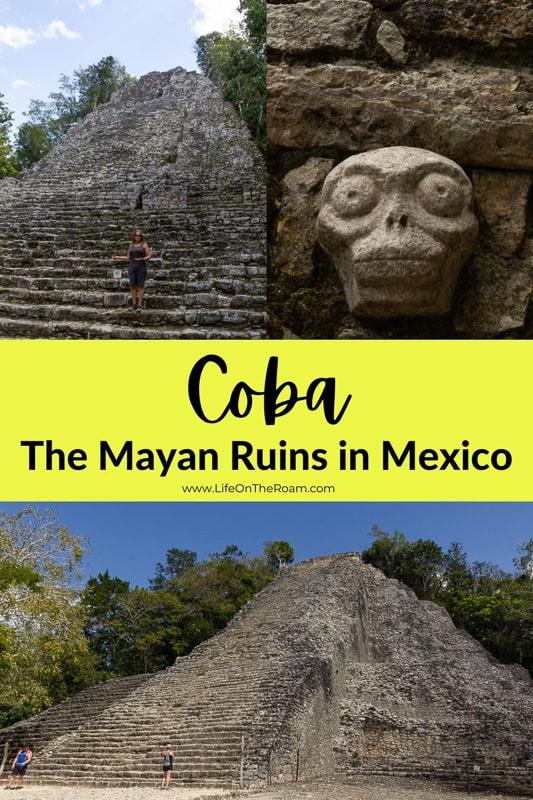
Table of Contents
What is Coba Famous for?
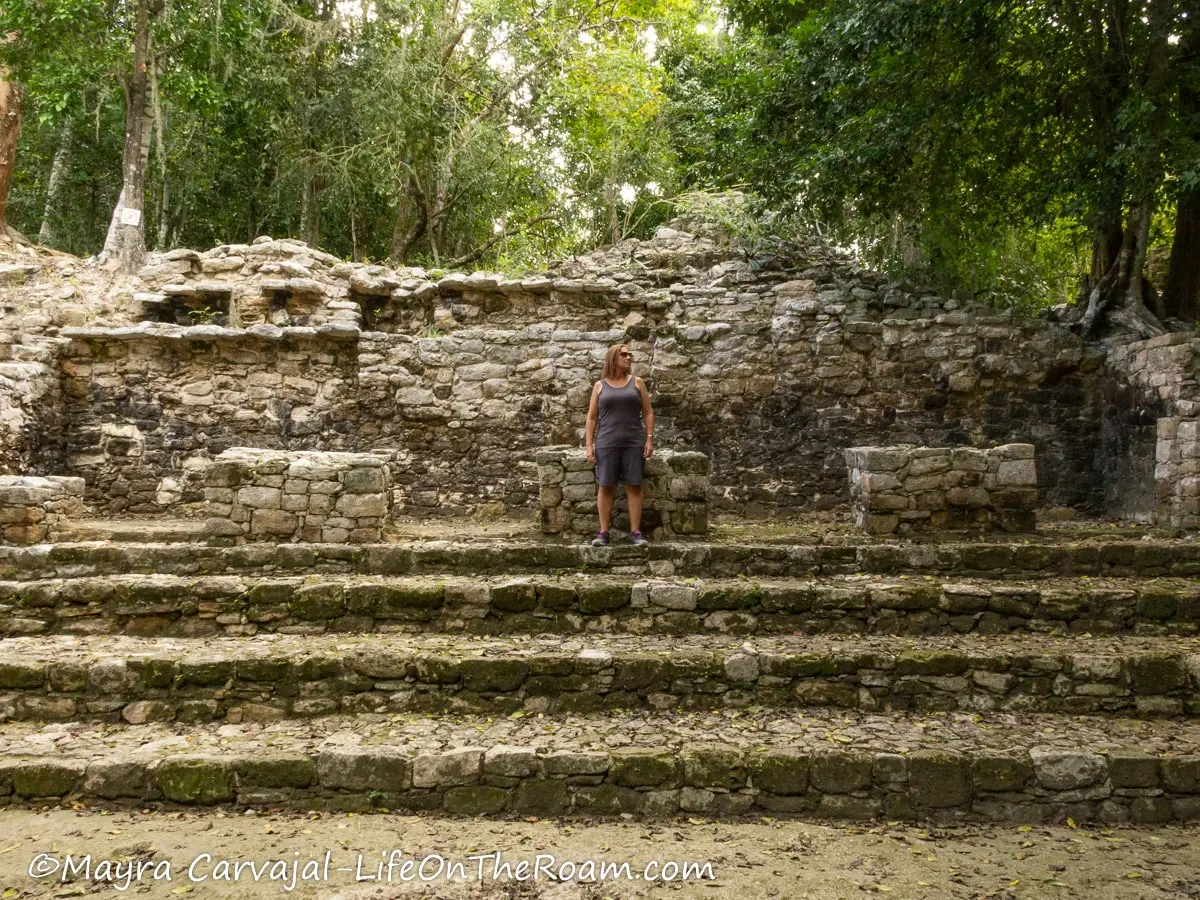
The buildings and squares of the ancient city of Cobá were built following a grid across an area of 70 square kilometres (27 square miles), making it the most widespread pre-Hispanic site in the northeast of the Yucatan Peninsula.
They chose limestone as the construction material, covering with thick stucco layers often painted in red and carved to make friezes. Murals adorned the exteriors but also some interiors.
The buildings across the site are connected by sacbe’ob (white roads) built between 600 and 800 A.D. These roads also linked Cobá to other ancient cities like Yaxuná, near Chichen Itzá.
(Sacbé 1 measures 100 kms and it’s the longest in the Mayan world).
Today, you can set foot on five of these pre-Hispanic roads within Cobá.
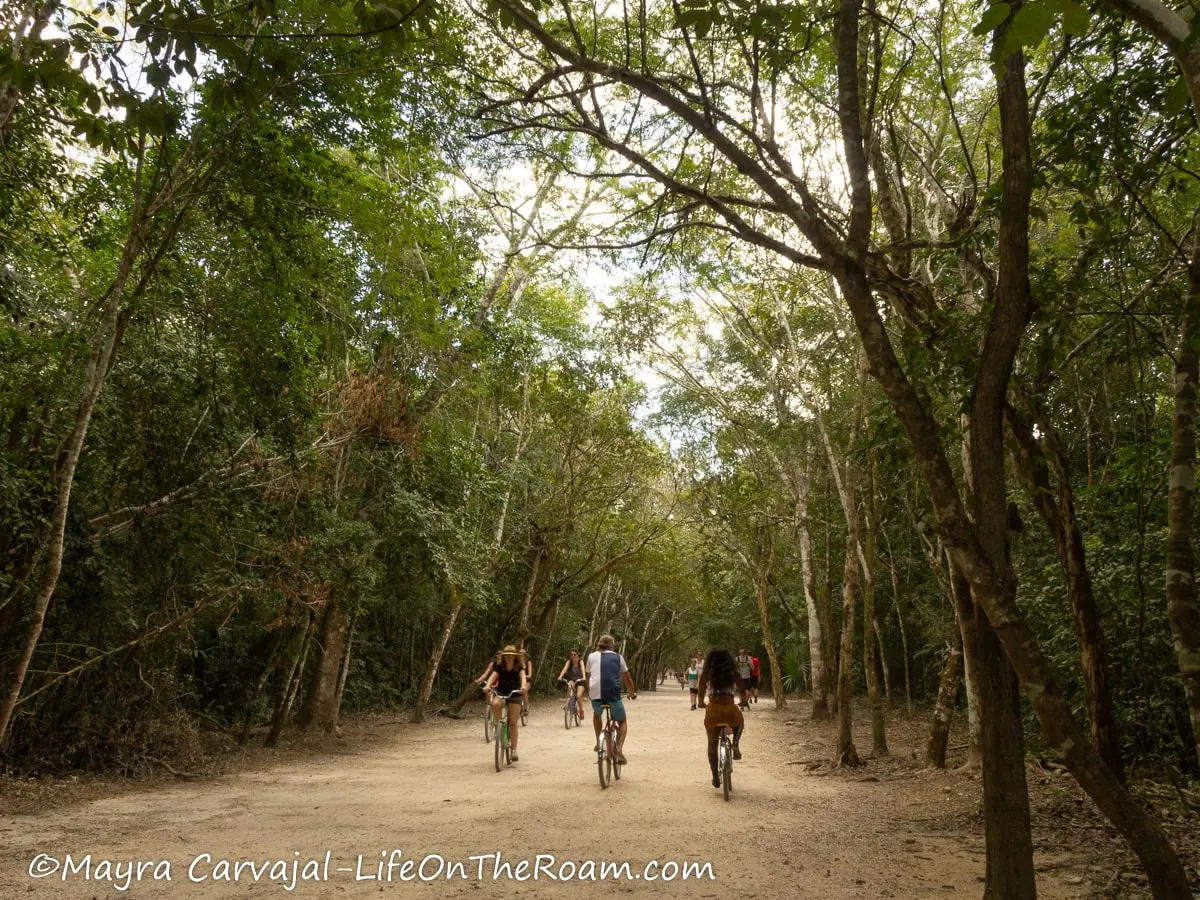
Another thing Coba is famous for are its many stelae: stone slabs carved to depict the life of important people of Cobá. They were like an Instagram post, but lasted way more. What we see today was posted between 600 to 800 A.D.
If you weren’t worth a stela you lived in the suburbs.
The golden era of Cobá happened between 800 and 1100 A.D. with buildings which resembled the ones in the southern region of the Mayan empire (what is today Guatemala).
Between 1250 and 1450 A.D. things started going downhill and it was Tulum’s turn to glow. With more than 6,500 structures mapped so far, there’s much more to uncover at Cobá.
Can You Still Climb the Coba Ruins?
Unfortunately (or fortunately for preservation purposes) climbing the Nohoch Mul pyramid is no longer allowed.
The Coba Archaeological Site
There are four main groups of buildings across the site:
The Cobá Group
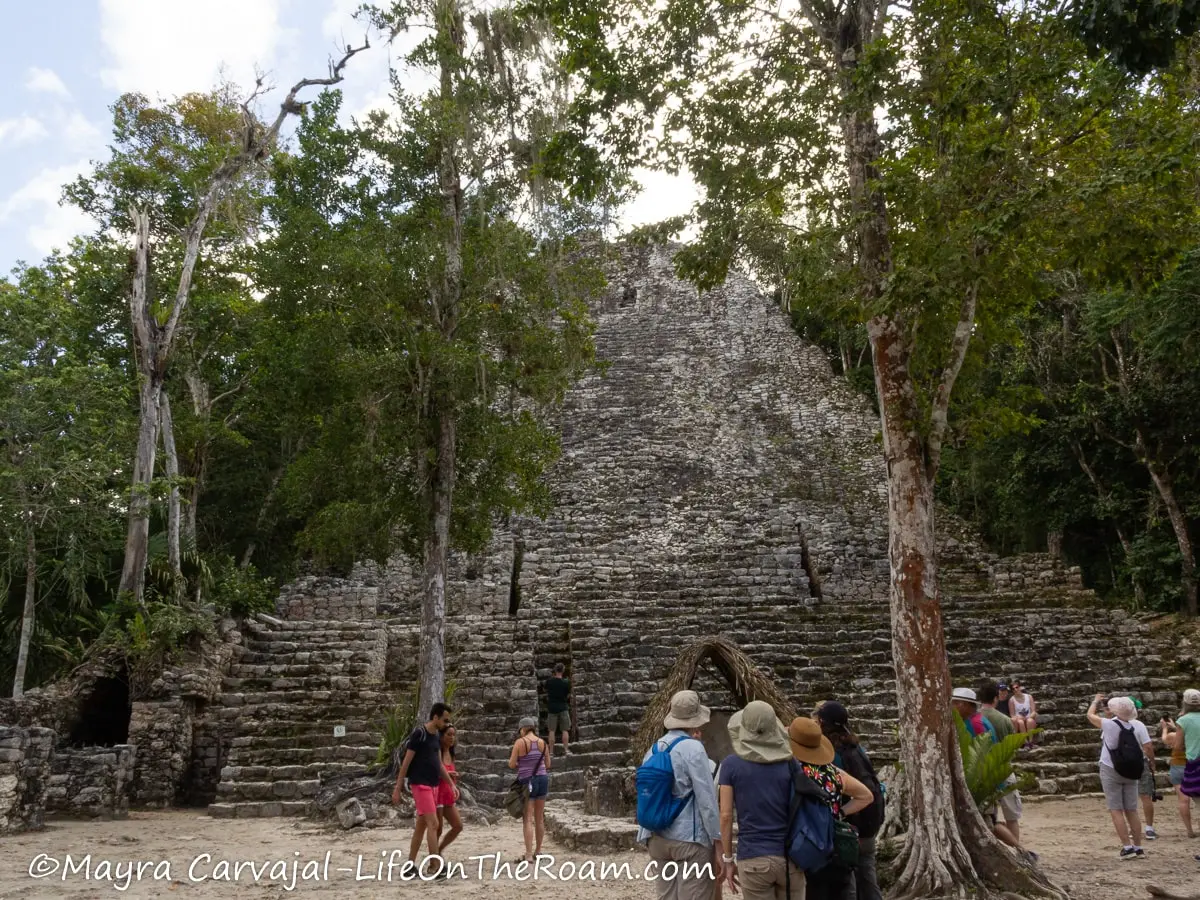
Close to the entrance and bordering Lake Macanxoc you’ll find the largest group of buildings on site (43 in total), along with stelae, courtyards and a plaza.
The most imposing structure is “The Church” (Iglesia). It’s 24 metres tall and, like many ancient buildings, it became larger as they added layers upon layers between 300-600 A.D. to 1000- 1450 A.D. You’ll see a stela in front of the Church covered by a thatch roof, with a circular altar.
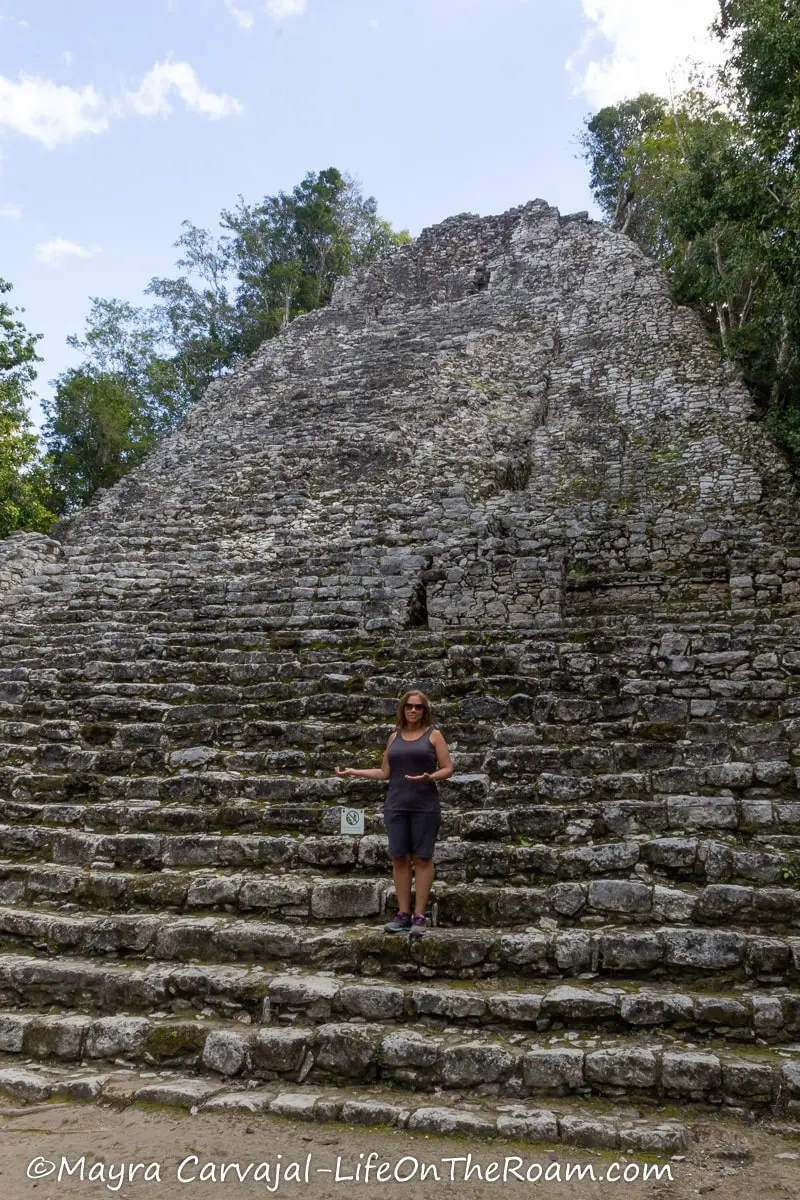
Another significant structure is the ball game court. The idea behind the ball game was to keep the heavy rubber ball in the air, with the caveat that they couldn’t use their hands and feet. The stone ring protruding from the slope? That’s where the ball had to go through (how the heck did they do that?).
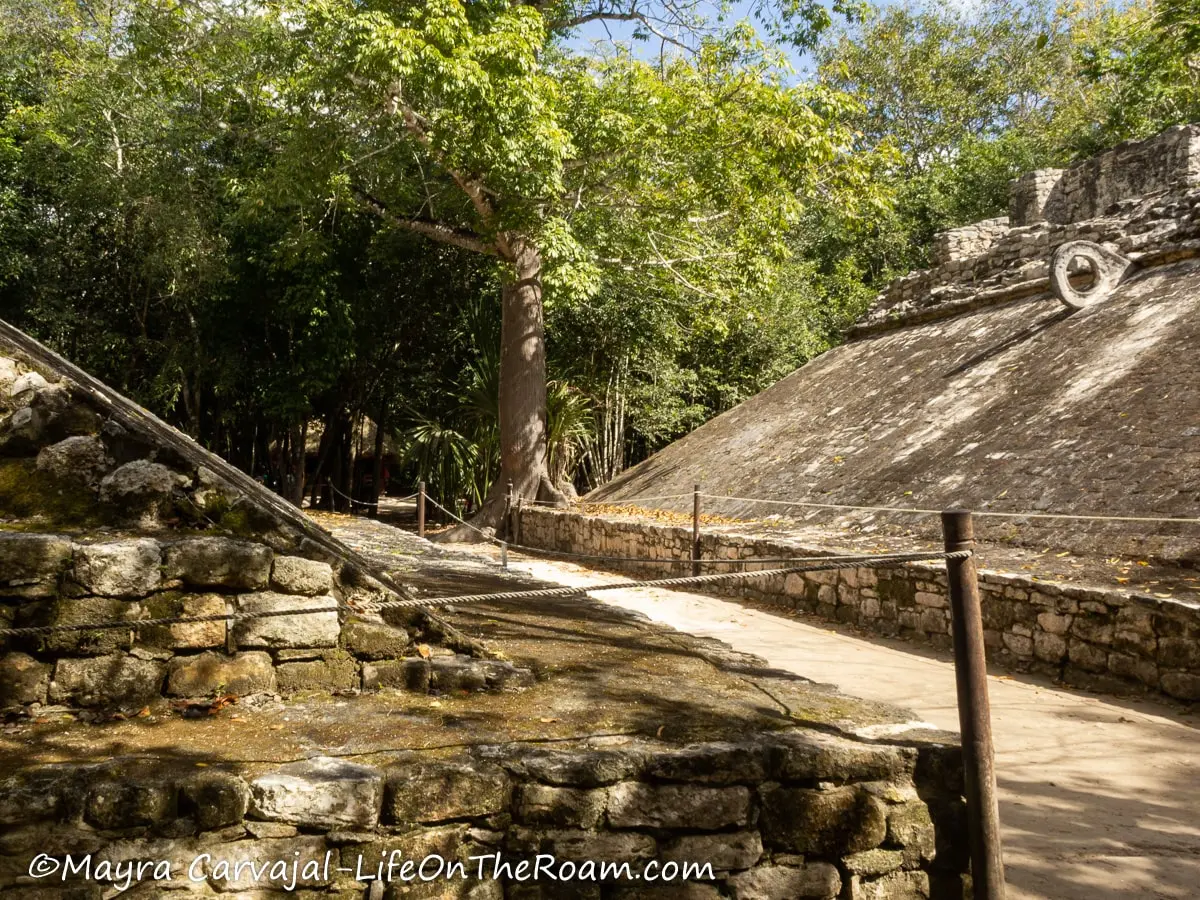
Historians think that the game went beyond simple entertainment and had a religious significance. At the end, the team losing the game would also lose their heads.
The Painting Complex
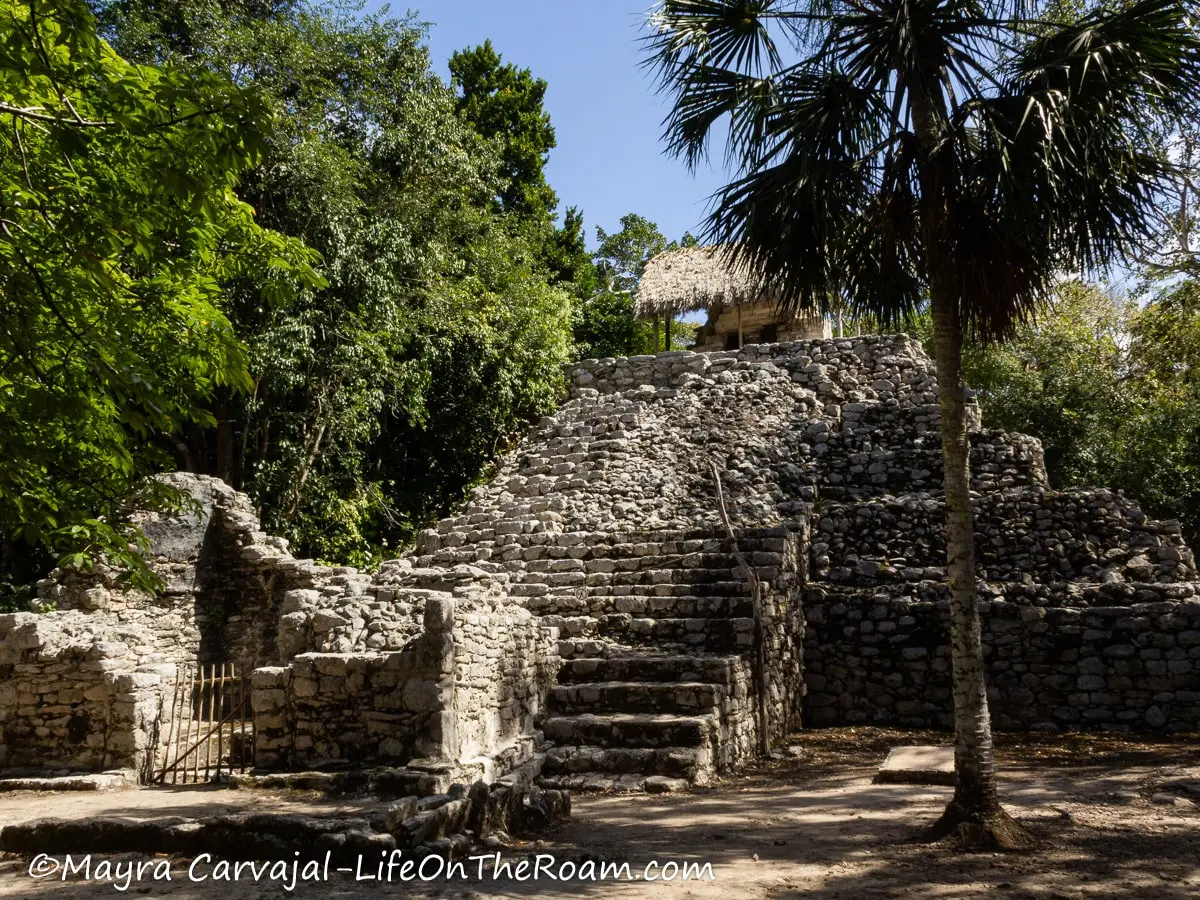
The buildings in the Painting Complex were amongst the last constructions in Cobá, dated between 1100-1450 A.D.
Here you’ll see a pyramidal structure crowned by a temple where there are some amazing paintings (hence the name). We’ll have to trust what the sign says because the temple is out of reach and this is what I was able to capture with the zoom of my camera, where you can see traces of red and blue paint.
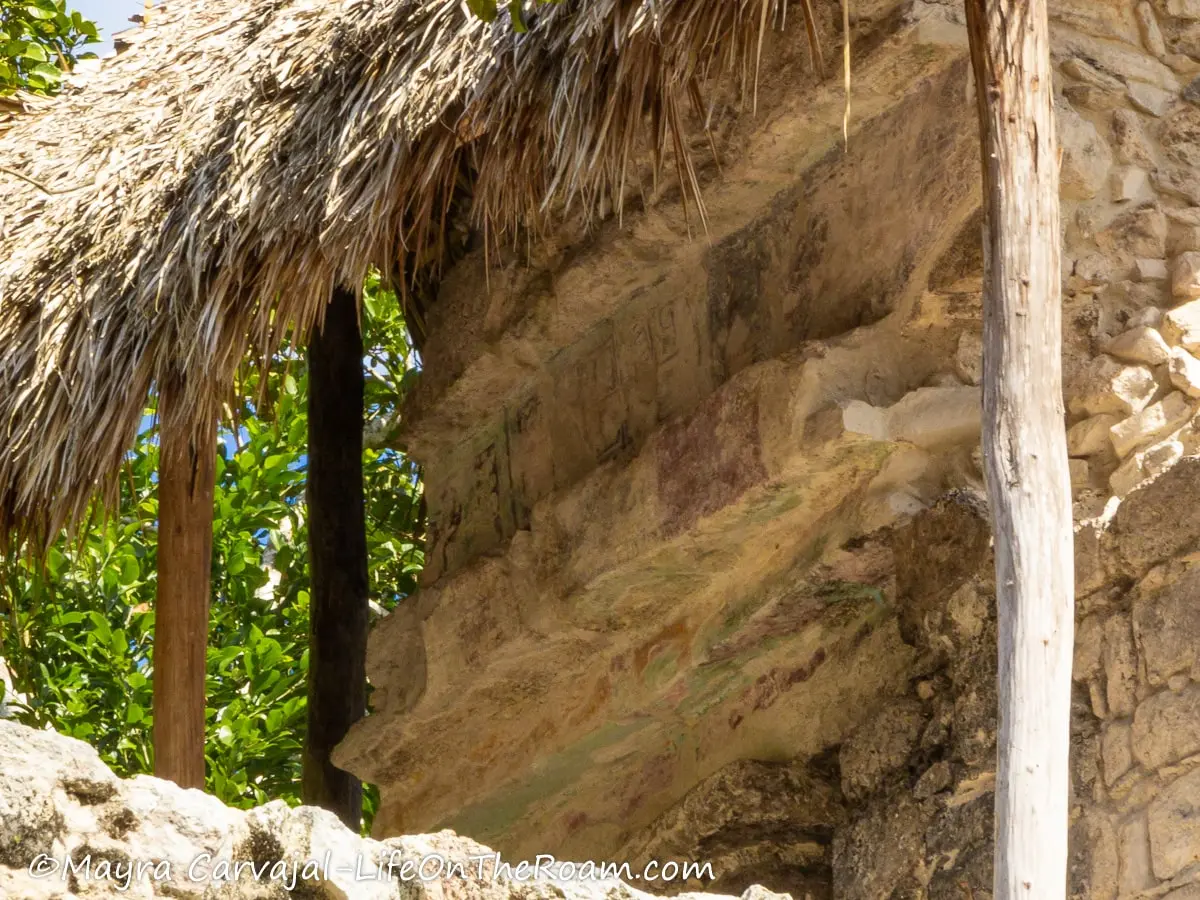
So yes, there are paintings up there. If you have a better zoom than mine you may be able to see more. I wish there would be a sign next to the building with a picture of the painting so we could see all the details.
Across you can walk around what used to be 13 altars under a roofed building that’s long gone. Archaeologists think rituals took place here.
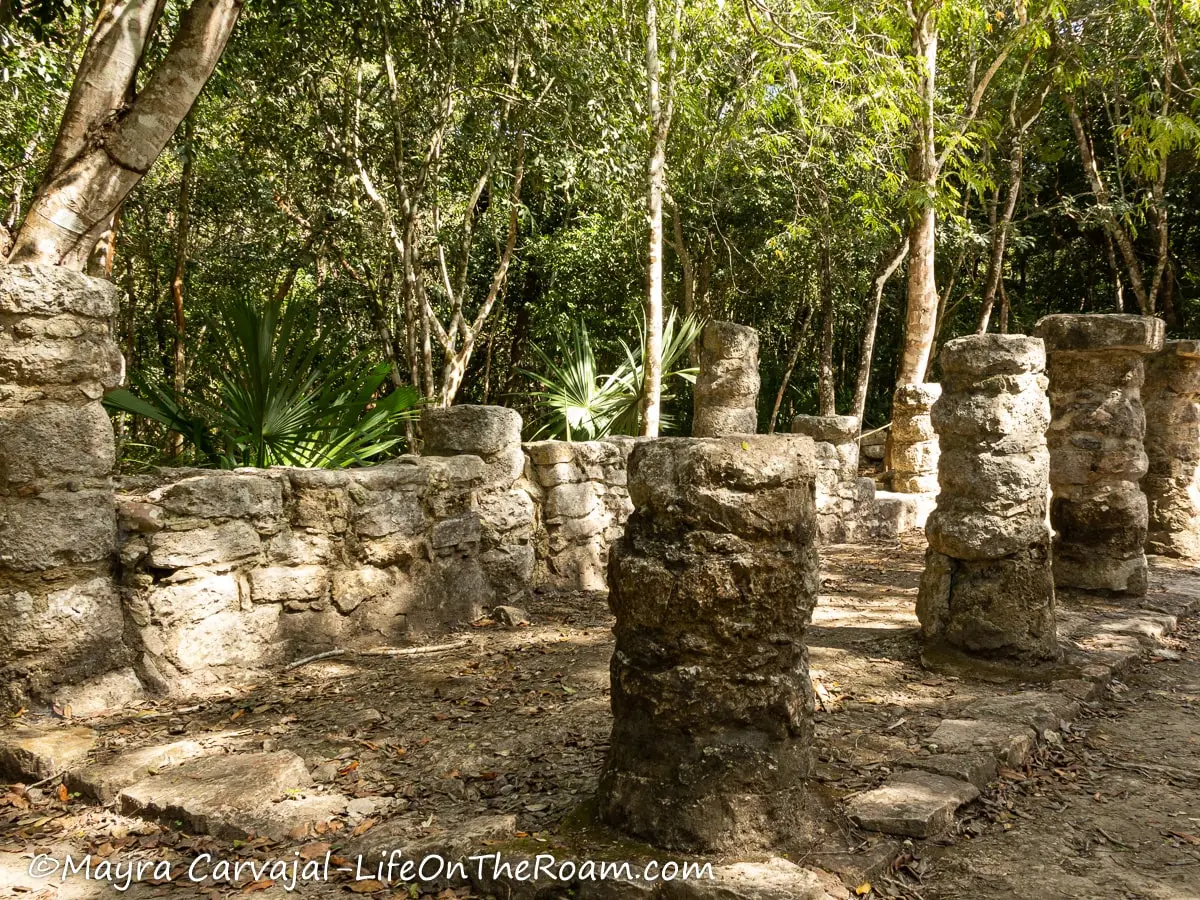
The Nohoch Mul Group
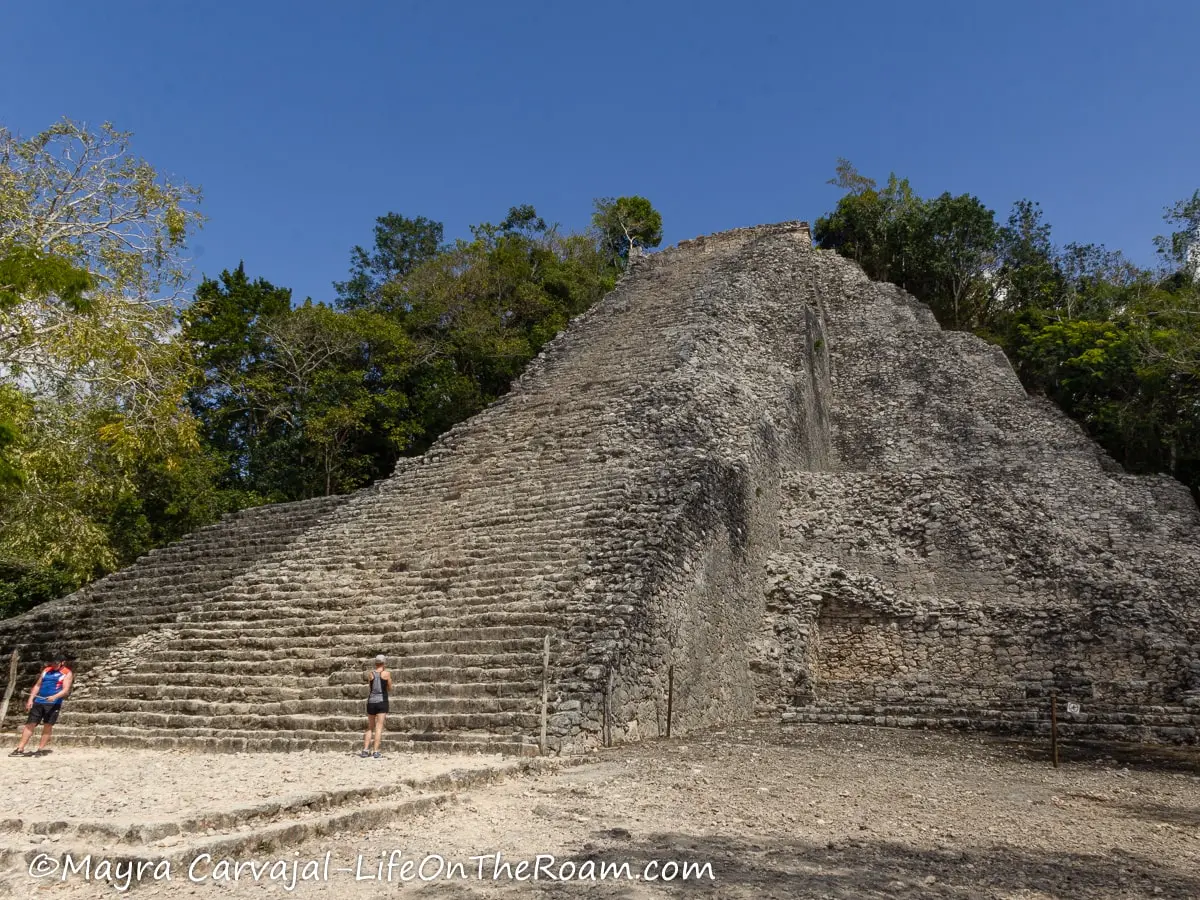
Between 1100 and 1450 A.D. someone said Let’s build a pyramid on that hill. And after looking at its 42 metre-high pinnacle (the site’s tallest) someone else said Let’s call it Nohoch Mul, meaning “big mound” in Mayan.
The Nohoch Mul pyramid has a peculiar shape as it seems that a portion was carved out on the right side.It has a main staircase leading to a temple at the top and a shorter one to the left leading to a vaulted room.
You’ll find a second ball game court, larger than the one in the Cobá group, with a marker stone in the shape of a skull and inscriptions on the slopes. There’s also a Grand Platform (unfinished) and several stelas, including Stela 20 -the best preserved stela on site- dated November 30th, 780 A.D.
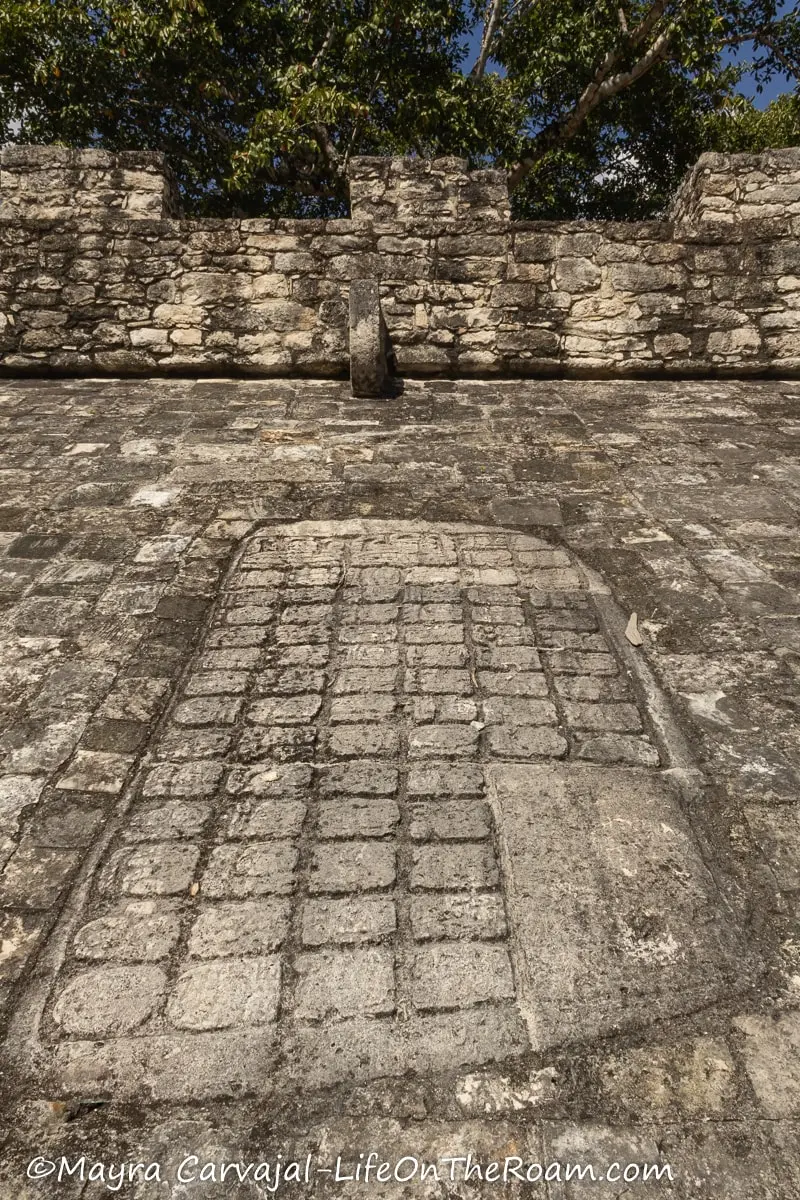
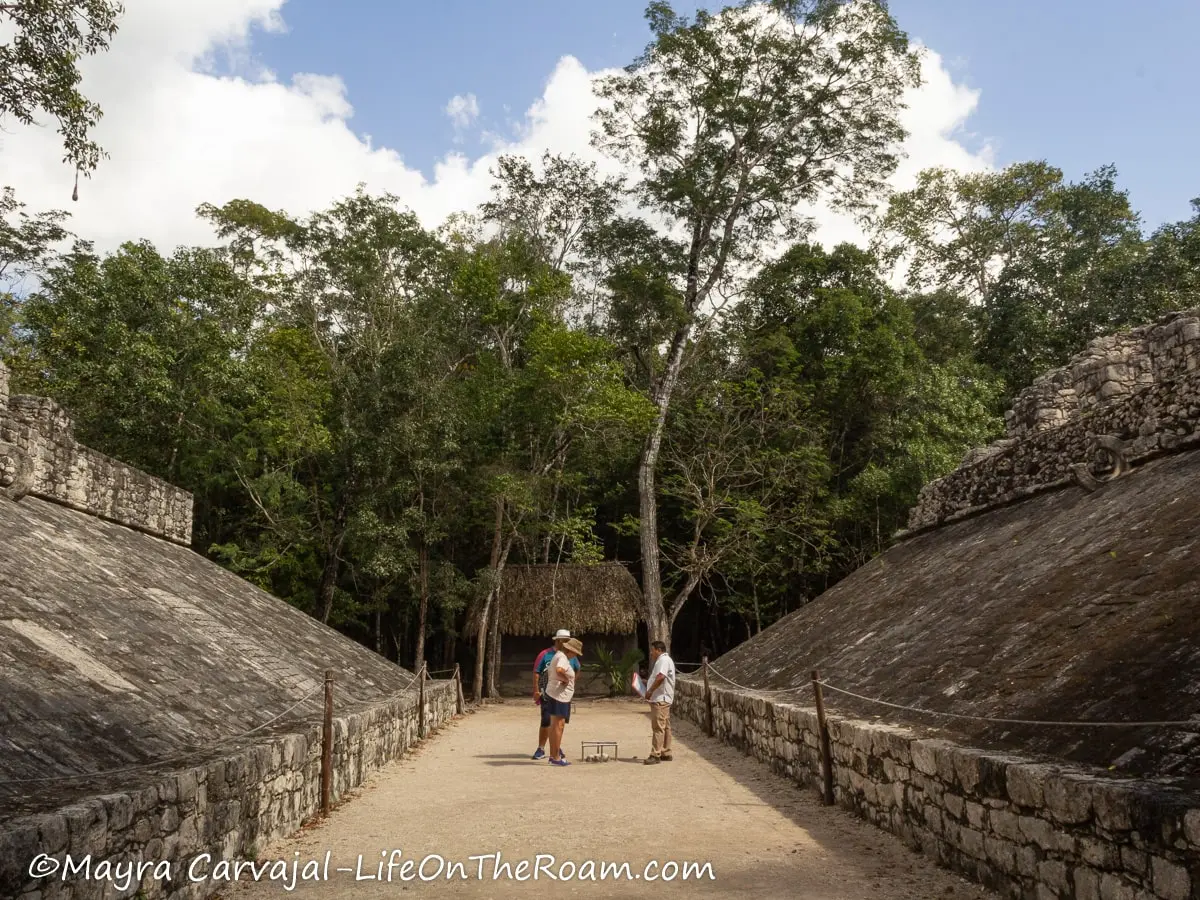
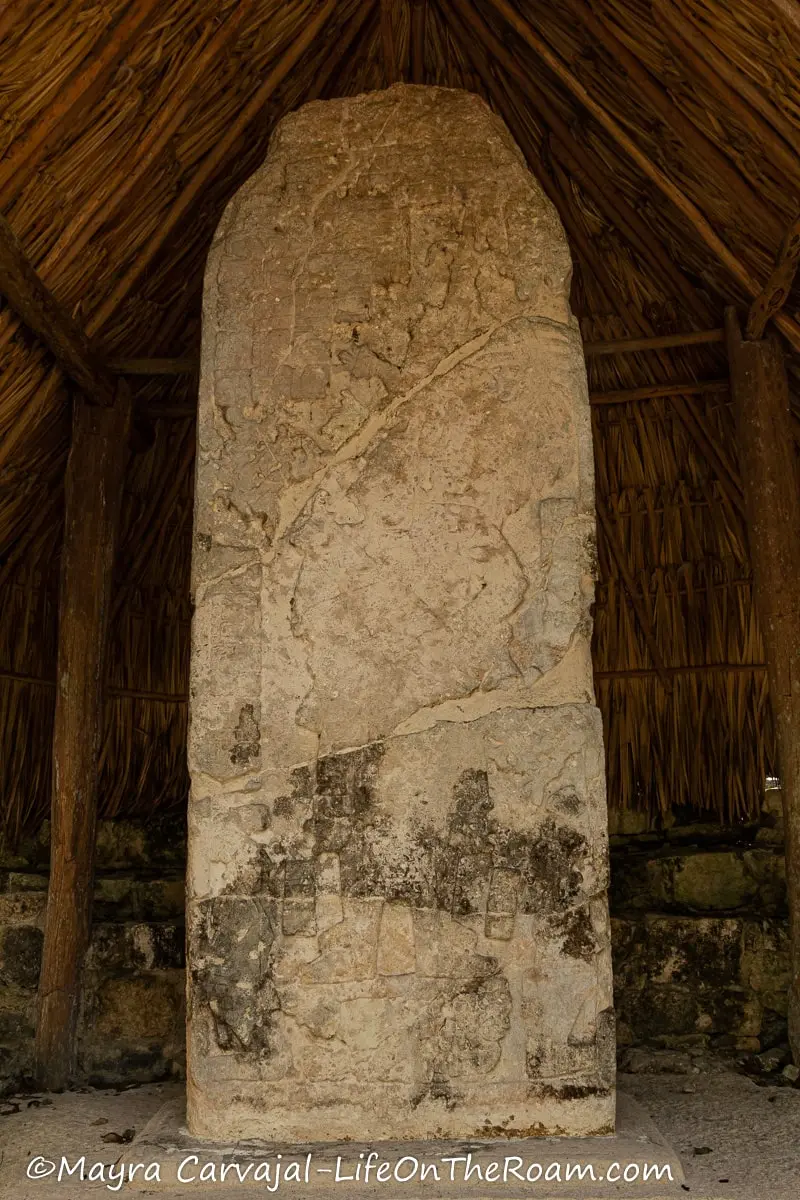
The Macanxoc Group
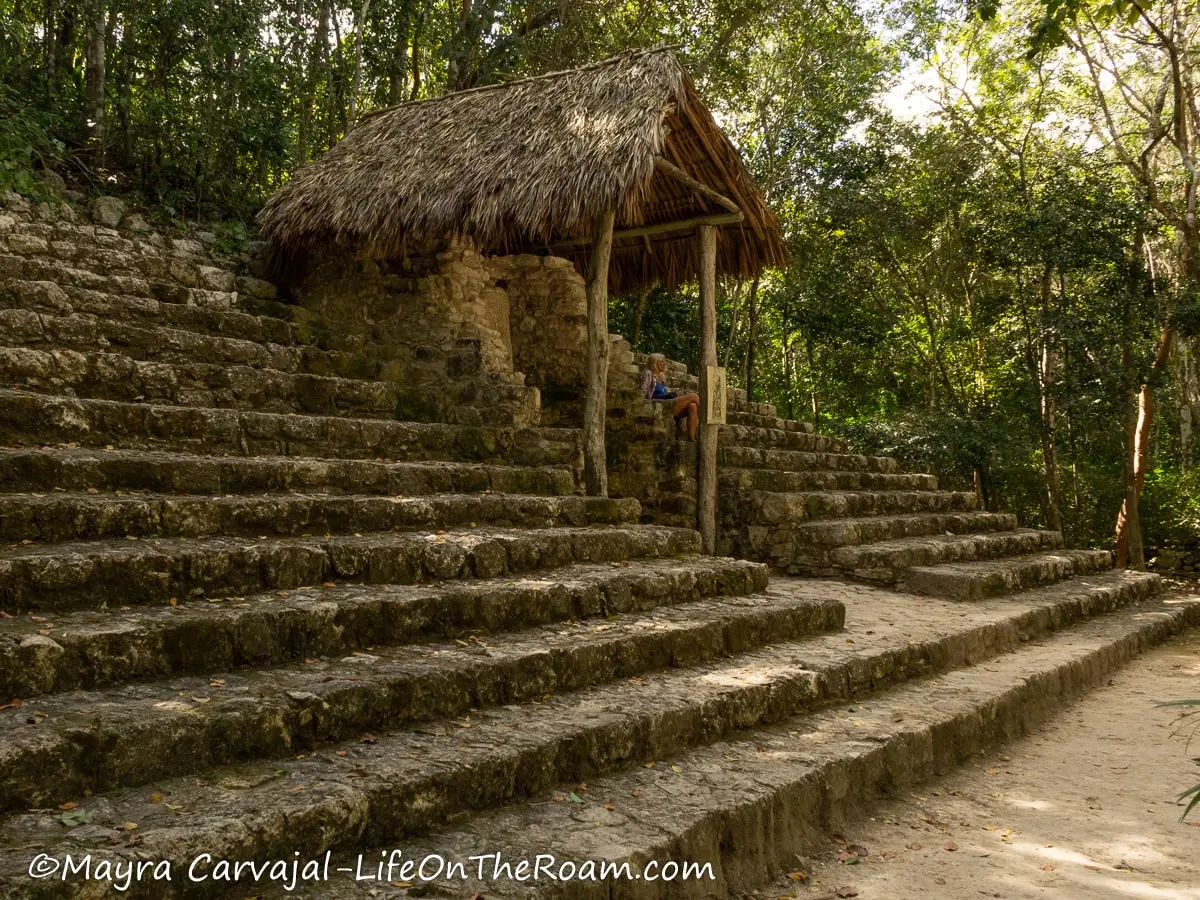
Welcome to “stelapalooza”. The conglomeration of stelae and monolithic altars around this area led archeologists to believe that this was the designated spot for ceremonies. An important finding in the Macanxoc group is Stela 1, carved all around with 313 hieroglyphs.
I liked that next to the eight stelae there are line drawings to help you “see” the carved figures (they’re from the 7th century A.D. and erosion has taken a toll). The common theme is a guy with fancy attire holding a sceptre, with prisoners at his feet and by his side. The scene is framed by hieroglyphs.
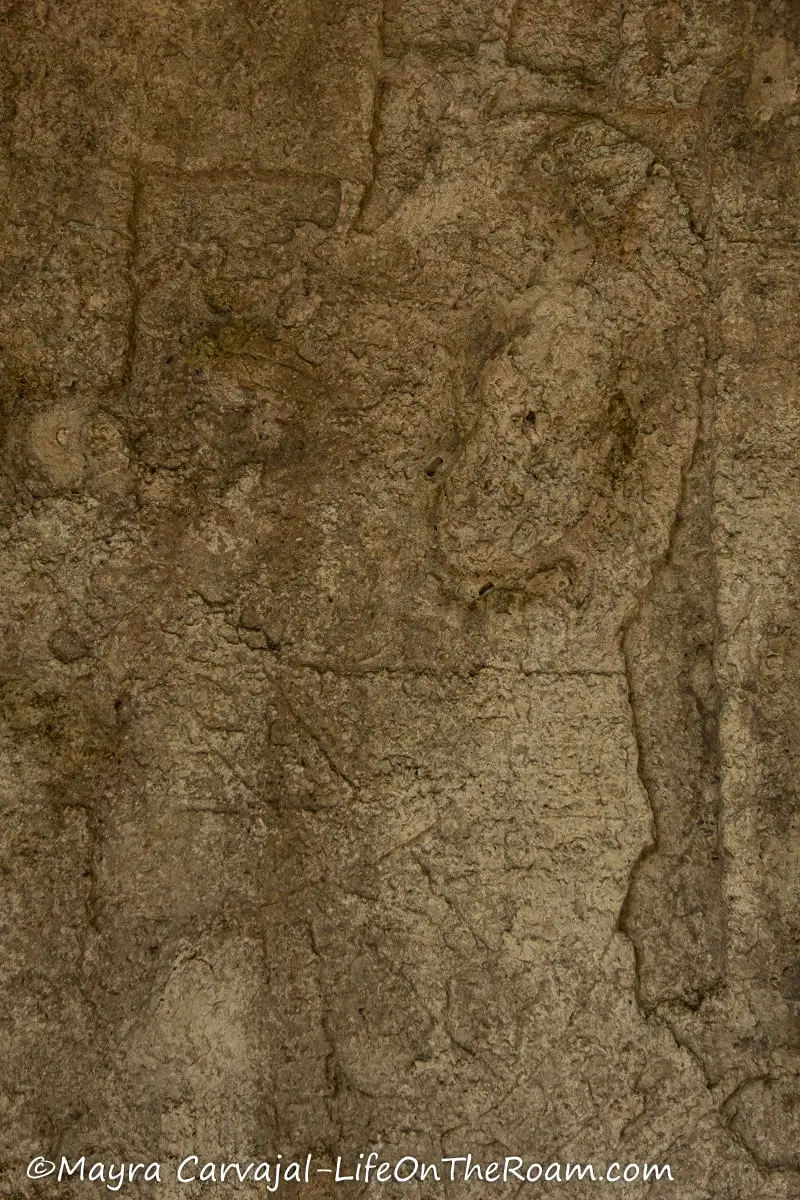
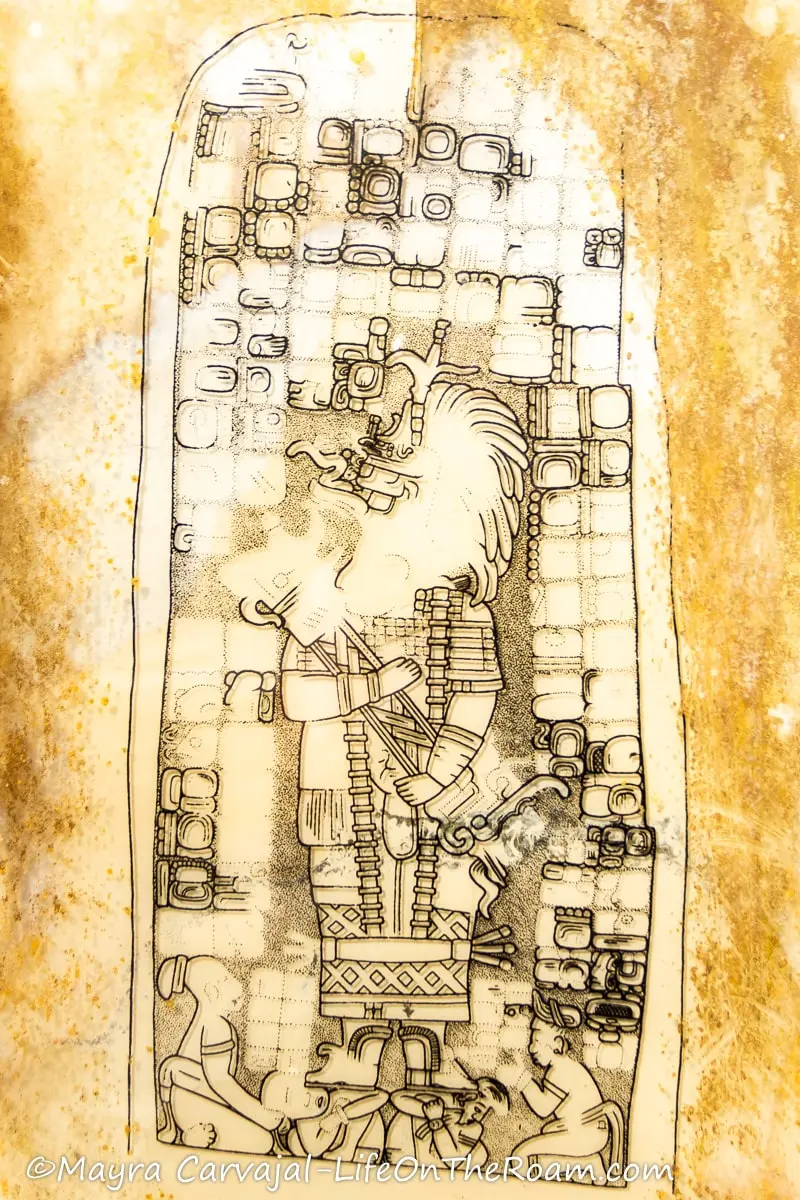
There‘s more to Macanxoc than stelae. So far they have found three tall buildings waiting to be explored as well as other structures. The scattered buildings, not arranged in a clear layout, is another distinctive feature of this group.
We also saw some cute wildlife around, including several ocellated turkeys near the entrance, found only in the Yucatan Peninsula and some parts of Belize, and some birds in the lake nearby.
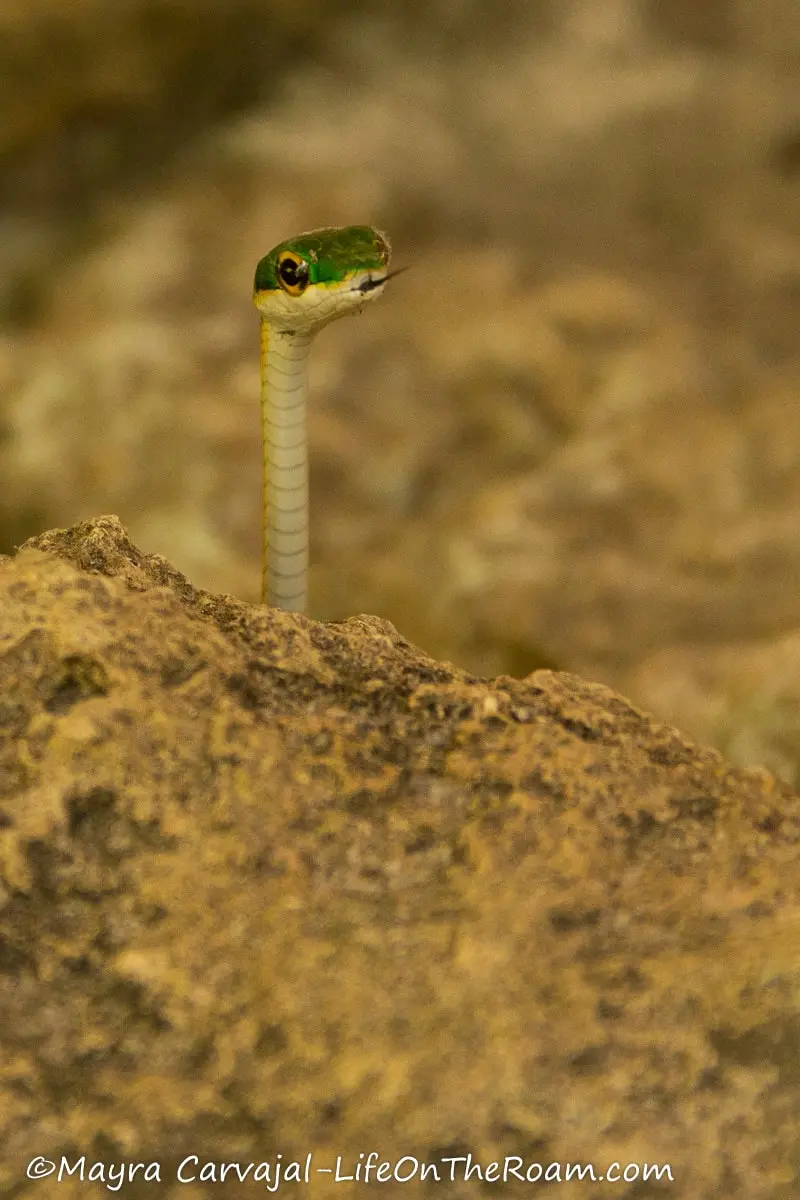
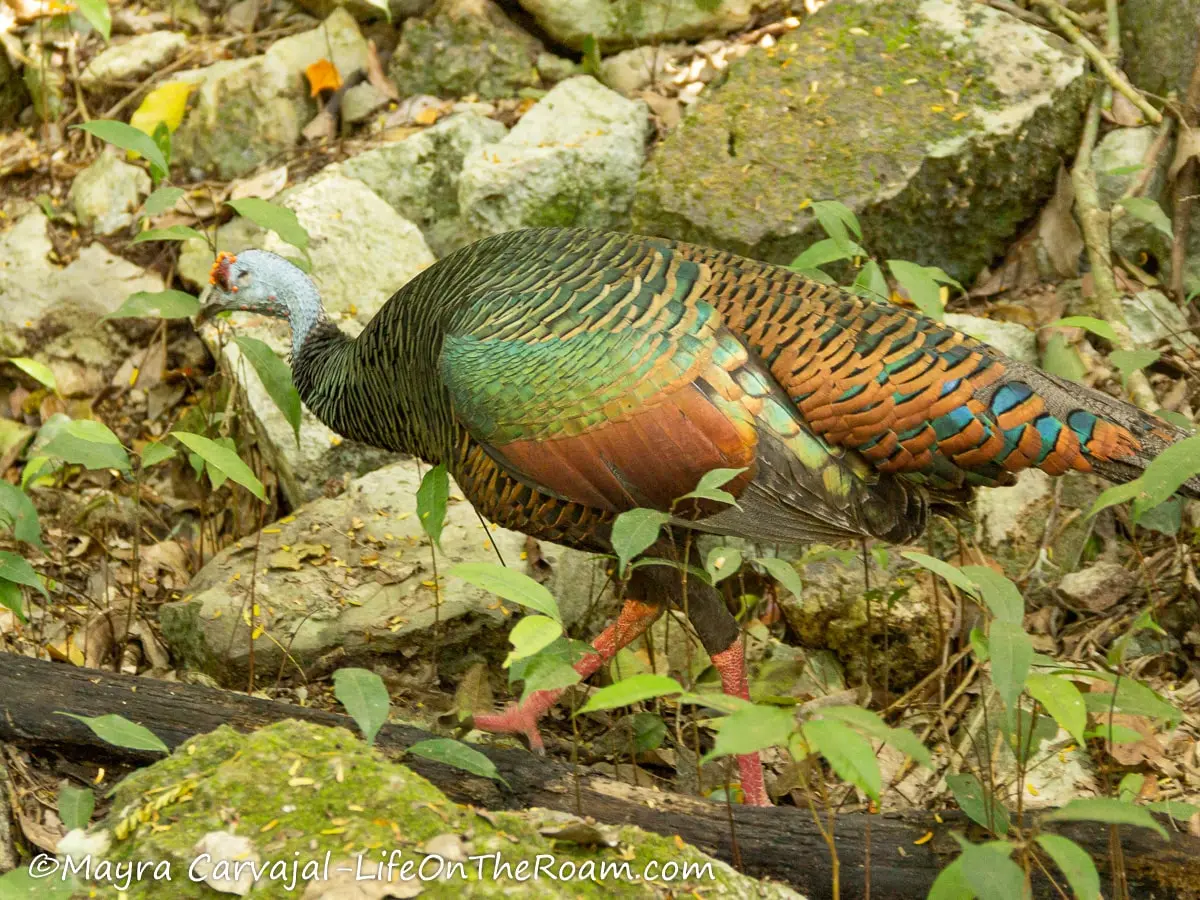
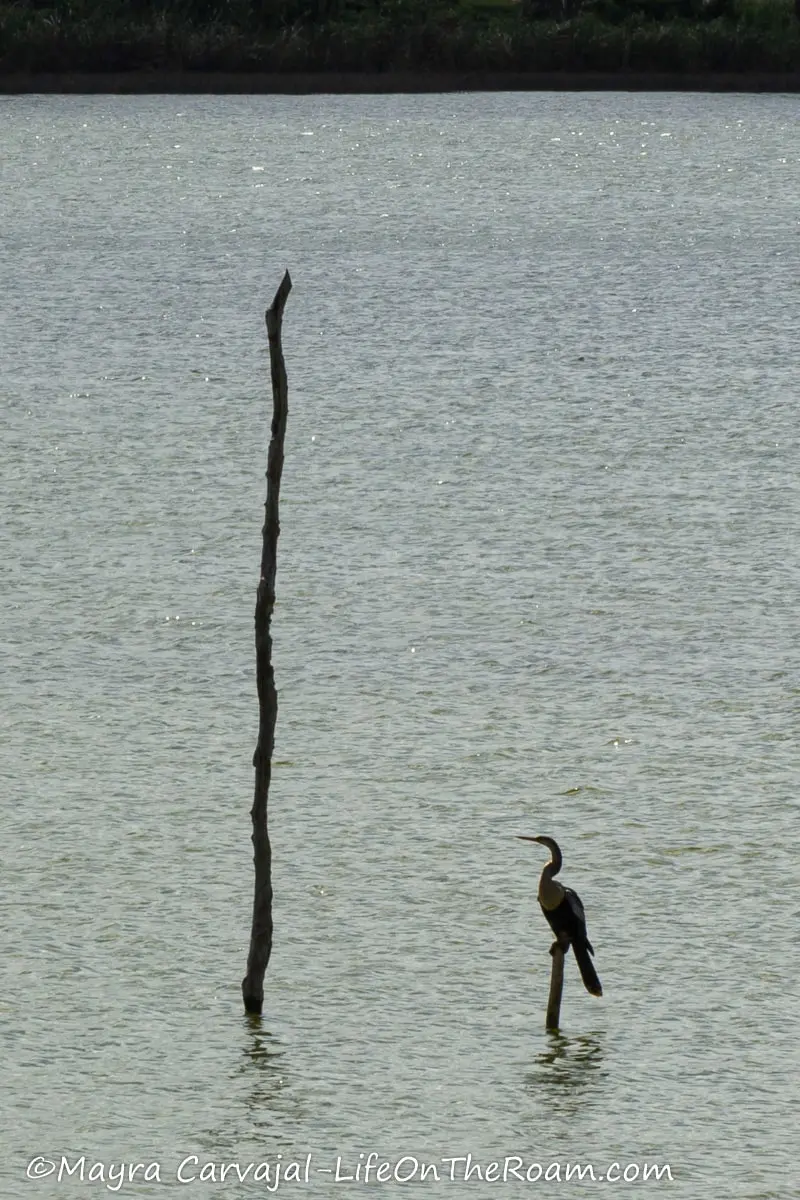
Best Tours to Visit the Coba Ruins
You can reach the Coba ruins by public transit, but if you want everything arranged for you or if you want to combine a visit to Coba with other experiences and you don’t want to rent a car, check out these highly rated tours.
PRIVATE (HALF DAY) TOUR TO COBA: departing from the Tulum and Akumal area, a guide will give you an insight into Coba’s history.
Book this tour, with a rating of 5/5 based on more than 55 reviews.
SMALL GROUP TOUR TO COBA, TULUM, CENOTE AND BEACH: offering a guided visit to Cobá and Tulum, a stop at cenote Choo-Ha, and at Paradise Beach. It includes a buffet lunch and all entrance fees.
Book this tour, with a rating of 4.7/5 based on more than 755 reviews.
TOUR TO COBA AND PUNTA LAGUNA NATURE RESERVE: combine your visit to Coba with an outdoor adventure at Punta Laguna: hike in the jungle and see wildlife, zipline, kayak, and swim in a cenote. Lunch is included. 10 people max.
Book this tour, with a rating of 5/5 based on more than 385 reviews.
SMALL GROUP CHICHEN ITZA, CENOTE AND COBA TOUR: guided visit to Chichen Itzá and Cobá, and swim in cenote Ik Kil. Departing from Playa del Carmen, it includes entrance fees, breakfast, and buffet lunch.
Book this tour, with a rating of 4.7/5 based on more than 180 reviews.
Visit the Cenotes Near the Coba Ruins
Cenotes are large sinkholes filled with freshwater where you can swim. Near the site there are three: Choo-Ha,Tankach-Ha, and Multum-Ha.
You can rent a bicycle at Cobá and pedal your way to these cenotes. The entrance fee is MXN$100 (each).
Coba vs. Tulum
Even though the pyramids at Cobá aren’t fully restored, I find them more impressive than those at Tulum. However the ruins at Tulum are unique in the sense that they’re the only Mayan ruins located on the shore.
Tulum gives you the chance to combine a trip to the beach (beware of the sargassum, though) with a visit to an archeological site with amazing ocean views from a cliff.
On the other hand, at Cobá you can rent a bicycle and visit three cenotes and the walk around the site is more pleasant, shaded by the rainforest canopy.
Last, although Cobá is popular, it’s not as popular as Tulum, which means less crowds.
Coba vs. Chichen Itzá
I love Cobá, but when it stands next to a site as impressive as Chichen Itzá, there’s no comparison. If I had time to see only one, I would pick Chichen Itzá.
However, all that wonder comes with crowds because, of course, everybody wants to see it. Unless you’re at the door when it opens, you’ll be surrounded by hordes of people.
Cobá can get crowded, but it’s nowhere near the zoo Chichen Itzá turns into. If you want to avoid this, go to Cobá.
Cost is another factor. Chichen Itzá is more than six times more expensive. Again, it’s worth it, but if you’re on a budget, Cobá is a good alternative. Also, the buildings here have not been fully restored, giving you a sense of adventure as you feel as if you’re entering a recently discovered archaeological site in the middle of the jungle.
Coba vs. Ek Balam
This is a tough one because they’re very different sites and they’re both worth seeing.
The ruins at Ek Balam have unique architectural features, they’re in better shape, and they come with the added bonus that you can still climb the main pyramid. But they also come with a price tag that ‘s more than five times the price you pay at Cobá which some people find outrageous because it’s a small site with a nearby cenote for swimming.
Cobá is a much larger site, you can see two tall pyramids (can’t climb any, though), tons of stelae, and you can bike to three cenotes.
Tips to Visit Coba
Bring comfortable shoes: you’ll walk a lot on dirt roads as the groups of buildings are scattered throughout the site. From the Cobá Group to Nohoch Mul it’s one kilometre one-way (0.6 miles) and from the Painting Complex to the Macanxoc Group it’s another kilometre one-way.
It’s a nice, flat walk under shade where you’ll also have the chance to see wildlife. If you’re used to walking you’ll enjoy it, unless it gets too hot, which in that case…
Bicycles and tricycles are available for rent: if it gets too hot, or you have mobility issues, or you’re in a hurry, you can rent a bicycle for MXN$65 per person or have someone driving you around in a tricycle for MXN$150 (for two people).
If you walk around you may spend around three hours at the site but if you rent a bicycle you can save one hour.
Try to go in the morning: less humidity and less crowds as you’ll beat the tours.
Bring mosquito repellent: it’s a jungle.
Bring water (and a snack): again, it’s a jungle and despite the shade, it’s humid.
Don’t go on Sundays: it’s free for nationals therefore it will be packed.
The site is open daily: 8AM-4PM (last entry is at 3PM)
General admission: MXN$100 (credit cards accepted).
How to Get to Coba by Bus
To get here by public transit from Cancun or Playa del Carmen take the ADO bus to Tulum. Don’t board the one that goes to the archaeological zone (it says “Ruinas”). That one goes to the pyramids; you need to go to the bus station in the town of Tulum.
From there you’ll find colectivos (vans) to Cobá. They leave every hour or so, when they fill up.
For bus schedules download the ADO app to your phone.
It’s not too complicated but if you don’t want to hop from bus to bus you can rent a car, drive in Tulum’s direction, and get off at Cobá’s road.
Did you already pull out your Indy hat? Or do you prefer to see more restored archaeological sites? If you like both, the Yucatan Peninsula is a great place for history lovers as you can visit several sites in one day.
YOU MAY ALSO WANT TO READ
BOOKING FLIGHTS AND ACCOMMODATIONS
Book your flight without losing your shirt
We check Momondo to find great deals to book our flights. Also, check Great Escape: it combines the listings from Expedia, Kiwi, Kayak, (and Skyscanner on the premium service) to find the best airfares.
To find a place to stay for less
Booking.com: this site combines everything under the sun. You’ll find hotels, apartments, B&B, hostels, rooms, etc., with all sort of filters to make your search a breeze.
Hotwire: the first site I check when we plan to stay at a hotel for a few nights. You can save anything from 20% to 60%. Use the search filter to find what you want and you’ll end up with three listings that match your criteria. You’ll know which one you’ll get after you book. If you can handle a little bit of uncertainty you can score big savings.
House Sitting: you take care of people’s pets and house for free while staying for free. It’s the closest thing to experiencing a place “like a local”. But it comes with responsibilities… Are you an animal lover? It may become your new way to travel.
To get travel insurance
SafetyWing: travel medical insurance that gives us peace of mind knowing that we’re covered in case of emergency. It’s convenient, affordable, and suitable for digital nomads who spend a long time outside their home country.
Check the full list of travel resources on my Resource Page for more options and savings
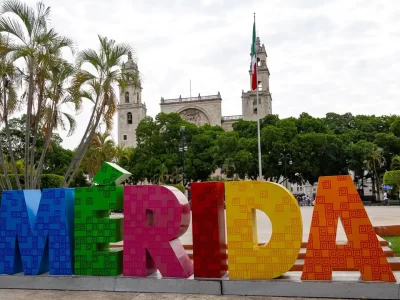
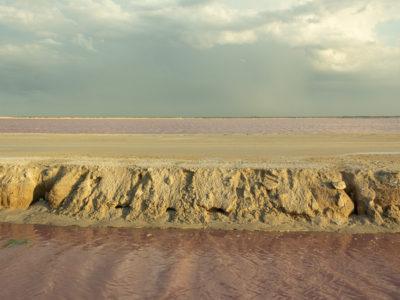
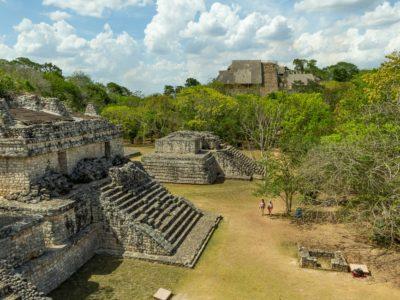
You provide such amazing facts along with great tips and stunning photos! This is a perfect post for anyone looking to plan a visit. Thanks for putting it together!
Thanks for reading!
While not Mayan, I just learned a while back that I do have a trace of Native American ancestry. Either way, this sparked a desire to learn more about various Native American cultures, including the Mayans. The Mayan ruins in Mexico is definitely on my list of travel destinations. I just have to find friends to go with that are willing to go beyond the typical tourist spots, like Tulum. Thank-you so much for all of this helpful information. I feel more prepared!.
Coba is a great spot to explore beyond the typical visit to Chichen Itza and Tulum. Thanks for reading and I hope you make it to Mexico soon.
This was such and amazing and interesting post! Your photos are amazing too! Thank you for the detail and information here!
Thanks for reading!
A great article, so informative thank you and another place to add to our South America Itinerary
Mexico is fascinating and a great addition to any bucket list